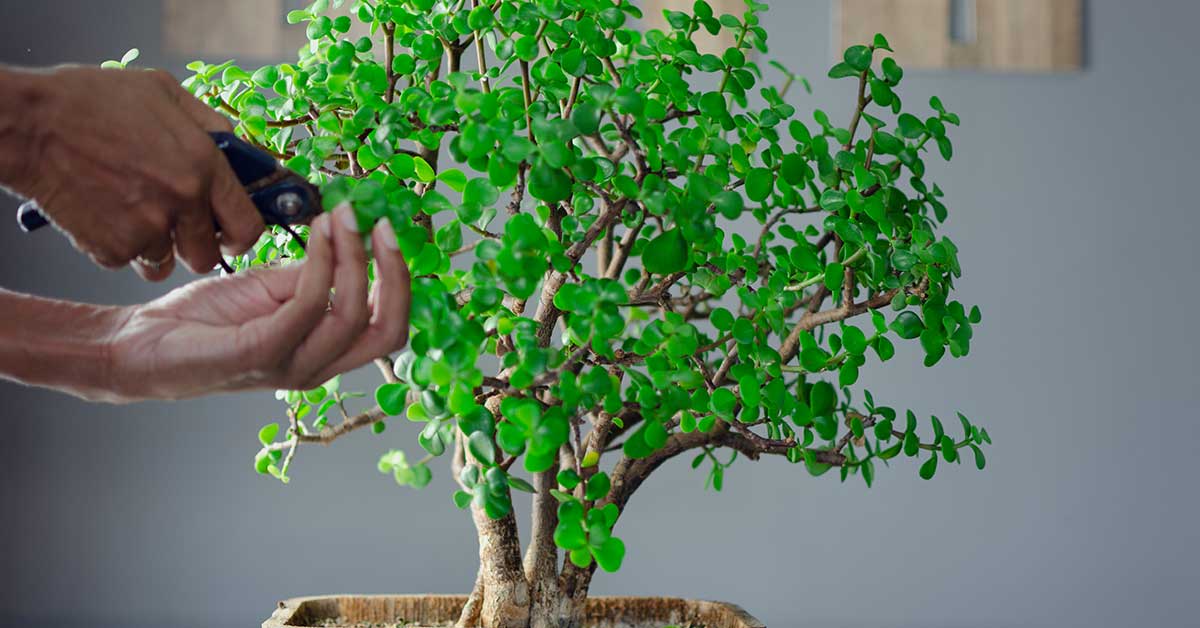I love growing jade plants! When I lived in southern California, I grew them outside year-round. They could get pretty big! I find them so calming and peaceful to work with as a gardener. They are definitely one of my favorite plants. They’re quite hardy, so they don’t need a lot of care to thrive. I definitely recommend giving jade plants a try if you’re looking for a low-maintenance houseplant. Pruning jade plants, by trimming back some of the stems and leaves, can help give it a fuller appearance and remove any unhealthy or dead growth from the plant.
The jade plant is a succulent evergreen shrub that is native to South Africa. It is a popular houseplant and is easy to care for, making it a great choice for beginners. It has thick, glossy, dark green leaves that are oval-shaped. The leaves are fleshy and can be up to 2-3 inches long and 1-2 inches wide. The jade plant has a thick and woody stem that can grow up to 3-4 feet tall and 1-2 feet wide. In the spring, clusters of small white or pink star-shaped flowers will bloom. The flowers are followed by small, round, fleshy fruits. The jade plant prefers bright, indirect sunlight and should be watered when the soil is dry to the touch. It should be fertilized with a balanced fertilizer during the growing season. The jade plant is an easy-to-care-for and low-maintenance houseplant, making it a great choice for any home.
Should you prune your jade plant?
Your jade plant will do well with pruning ideally once per year. Jade plants typically grow in an upright, tree-like shape with woody stems and thick, glossy green leaves. As they mature, the stems become woody and the leaves become thicker and darker in color. If you want a more tree-like jade plant, you may opt to not prune the plant, or prune its smaller secondary branches while leaving its main stem alone. But for a fuller, bushier-looking jade plant, regular trimming is ideal.
Guide to pruning jade plants
The best time to prune a jade plant is in the spring or early summer just as new growth starts to come in. Pruning in the late summer or fall can cause damage to new growth. Pruning jades in the winter can weaken the plant, causing them to become leggy and unhealthy.
- Identify any dead, damaged, or diseased branches and leaves. These should be removed with a pair of sharp, clean pruning shears.
- Cut off any branches that are growing in an unruly or unbalanced manner. This will help to give your jade plant a neat, compact look.
- Cut back any stems that are particularly long or have outgrown the desired shape of your jade plant.
- If you wish to encourage branching, take the tip of a branch that is in the desired shape and cut it back by about one-third. This will encourage new growth and branching, giving it a bushier appearance.
- Clean up any fallen leaves or debris from the area around your jade plant. These can be used to make new jade plants! More on that in a moment.
- Give a thorough watering and apply a balanced, slow-release house plant fertilizer to your jade plant after pruning to help it recover from the pruning and encourage new growth.
Planting jade plant cuttings
After trimming your jade plant, an interesting opportunity presents itself to you: to make more jade plants! The cuttings you’ve just removed from your plant will readily propagate and make new jades. Even just a leaf very slightly buried in the soil will begin to grow. Here’s how to do it:
- Fill a 4-inch pot with well-draining potting soil and make sure to moisten it.
- Take a jade cutting with 2 to 3 leaves, and remove the lower leaves to expose the stem.
- Make a hole in the soil with a pencil and insert the jade cutting.
- Gently press the soil around the cutting to secure it in place.
- Water the soil until it is moist and place the pot in a warm location with indirect sunlight.
- Check the soil regularly and water as needed to keep it slightly moist.
- After a few weeks, the jade cutting should begin to show new growth. When the roots are well-established, you can transplant the cutting into a larger pot.













